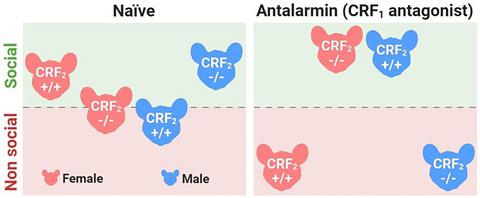当前位置:
X-MOL 学术
›
J. Neurosci. Res.
›
论文详情
Our official English website, www.x-mol.net, welcomes your feedback! (Note: you will need to create a separate account there.)
Sex-linked roles of the CRF1 and the CRF2 receptor in social behavior.
Journal of Neuroscience Research ( IF 4.2 ) Pub Date : 2020-05-29 , DOI: 10.1002/jnr.24629 Alessandro Piccin 1, 2 , Angelo Contarino 1, 2
Journal of Neuroscience Research ( IF 4.2 ) Pub Date : 2020-05-29 , DOI: 10.1002/jnr.24629 Alessandro Piccin 1, 2 , Angelo Contarino 1, 2
Affiliation

|
Dysfunctional social behavior is a major clinical feature of mood, anxiety, autism spectrum, and substance‐related disorders, and may dramatically contribute to the poor outcome of these diseases. Nevertheless, the mechanisms underlying social behavior deficits are still largely unknown. The corticotropin‐releasing factor (CRF) system, a major coordinator of the stress response, has been hypothesized to modulate social behavior. CRF signaling is mediated by two receptor types, termed CRF1 and CRF2. Using the three‐chamber task for sociability (i.e., preference for an unfamiliar conspecific vs. an object), this study demonstrates that CRF2 receptor null mutation (CRF2−/−) reduces sociability in female mice but increases it in male mice. Both female and male CRF2−/− mice display a preference for social odor cues over neutral cues, indicating that sex‐ and CRF2 receptor‐dependent sociability is not due to altered olfaction or impaired social cues discrimination. Moreover, treatment with the CRF1 receptor‐preferring antagonist, antalarmin, consistently induces sociability in non‐social mice but disrupts it in social mice, independently of CRF2 receptor deficiency. Sex, CRF2 receptor deficiency, or antalarmin affect locomotor activity during the three‐chamber test. However, throughout the study CRF1 and CRF2 receptor‐linked sociability is independent of locomotor activity. The present findings highlight major functions for the CRF system in the regulation of social behavior. Moreover, they provide initial evidence of sex‐linked roles for the CRF1 and the CRF2 receptor, emphasizing the importance of sex as a major biological variable to be taken into consideration in preclinical and clinical studies.
中文翻译:

CRF1 和 CRF2 受体在社会行为中的性别相关作用。
功能失调的社会行为是情绪、焦虑、自闭症谱系和物质相关疾病的主要临床特征,并且可能极大地导致这些疾病的不良结果。然而,社会行为缺陷的潜在机制在很大程度上仍是未知的。促肾上腺皮质激素释放因子 (CRF) 系统是压力反应的主要协调者,已被假设可以调节社会行为。CRF 信号传导由两种受体类型介导,称为 CRF 1和 CRF 2。使用三室任务进行社交(即,偏好不熟悉的同种与对象),该研究表明 CRF 2受体无效突变(CRF 2 -/-)降低了雌性小鼠的社交能力,但在雄性小鼠中增加它。雌性和雄性 CRF 2 -/- 小鼠都表现出对社会气味线索的偏好,而不是中性线索,这表明依赖于性别和 CRF 2受体的社交能力不是由于嗅觉改变或社会线索辨别力受损。此外,CRF 1受体偏好拮抗剂antalarmin 的治疗持续诱导非社交小鼠的社交能力,但会破坏社交小鼠的社交能力,与CRF 2受体缺陷无关。在三室试验期间,性别、CRF 2受体缺乏或安拉明影响运动活动。然而,在整个研究过程中,CRF 1和 CRF 2受体相关的社交能力与运动活动无关。目前的研究结果突出了 CRF 系统在调节社会行为方面的主要功能。此外,它们提供了 CRF 1和 CRF 2受体性别相关作用的初步证据,强调了性别作为临床前和临床研究中需要考虑的主要生物学变量的重要性。
更新日期:2020-06-25
中文翻译:

CRF1 和 CRF2 受体在社会行为中的性别相关作用。
功能失调的社会行为是情绪、焦虑、自闭症谱系和物质相关疾病的主要临床特征,并且可能极大地导致这些疾病的不良结果。然而,社会行为缺陷的潜在机制在很大程度上仍是未知的。促肾上腺皮质激素释放因子 (CRF) 系统是压力反应的主要协调者,已被假设可以调节社会行为。CRF 信号传导由两种受体类型介导,称为 CRF 1和 CRF 2。使用三室任务进行社交(即,偏好不熟悉的同种与对象),该研究表明 CRF 2受体无效突变(CRF 2 -/-)降低了雌性小鼠的社交能力,但在雄性小鼠中增加它。雌性和雄性 CRF 2 -/- 小鼠都表现出对社会气味线索的偏好,而不是中性线索,这表明依赖于性别和 CRF 2受体的社交能力不是由于嗅觉改变或社会线索辨别力受损。此外,CRF 1受体偏好拮抗剂antalarmin 的治疗持续诱导非社交小鼠的社交能力,但会破坏社交小鼠的社交能力,与CRF 2受体缺陷无关。在三室试验期间,性别、CRF 2受体缺乏或安拉明影响运动活动。然而,在整个研究过程中,CRF 1和 CRF 2受体相关的社交能力与运动活动无关。目前的研究结果突出了 CRF 系统在调节社会行为方面的主要功能。此外,它们提供了 CRF 1和 CRF 2受体性别相关作用的初步证据,强调了性别作为临床前和临床研究中需要考虑的主要生物学变量的重要性。


























 京公网安备 11010802027423号
京公网安备 11010802027423号